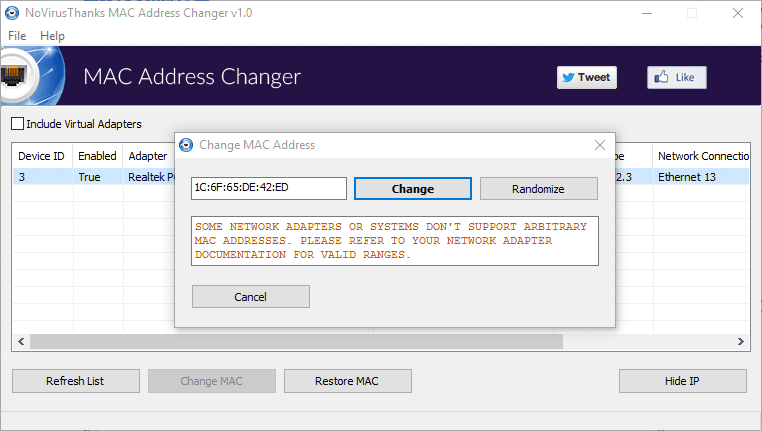

Open a Terminal window ( press Command + Space, type “Terminal,” and then press Enter.For testing purposes or even security reasons, you might consider changing your computer's MAC address, which requires specialized tools to make the process safe and easy.
NETWORK MAC ADDRESS CHANGE MAC OS X
RELATED: A Windows User's Guide to Mac OS X Keyboard Shortcuts Mac OS X’s System Preferences pane displays each network interface’s MAC address, but doesn’t allow you to change it. If you don’t, your MAC address will be reset when you restart. You’ll have to modify the appropriate configuration file under /etc/network/interfaces.d/ or the /etc/network/interfaces file itself if you want this change to always take effect at boot time.

Sudo ifconfig eth0 hw ether xx:xx:xx:xx:xx:xx Be sure to replace “eth0” with the name of the network interface you want to modify and enter the MAC address of your choice: sudo ifconfig eth0 down

This involves taking the network interface down, running a command to change its MAC address, and then bringing it back up. You can also do this the old-fashioned way. Apple’s iOS 8 will use a random MAC address each time it scans for nearby Wi-Fi networks to prevent this sort of tracking.įor example, in Ubuntu you’d click the network icon on the top panel, click “Edit Connections,” select the network connection you want to modify, and then click “Edit.” On the Ethernet tab, you’d enter a new MAC address in the “Cloned MAC address” field, and then save your changes. A company named Renew London used trash bins in the city of London to track people’s movements around the city based on their MAC addresses. When you walk around, your smartphone scans for nearby Wi-Fi networks and broadcasts its MAC address.

(Free, limited Wi-Fi may also be tracked using browser cookies or an account system.) Change your MAC address and you could get more Wi-Fi.
NETWORK MAC ADDRESS CHANGE FREE
For example, an airport Wi-Fi network might offer a free 30 minutes and then ban your MAC address from receiving more Wi-Fi. Device Identification: Many airport Wi-Fi networks and other public Wi-Fi networks use a device’s MAC address to identify it.You may need to change your router or computer’s MAC address to connect. MAC Authentication: Some Internet service providers may require authentication with a MAC address and only allow a device with that MAC address to connect to the Internet.This isn’t a great security tool because people can spoof their MAC addresses. MAC Address Filtering: Networks can use MAC address filtering, only allowing devices with specific MAC addresses to connect to a network.When a device connects, it always receives a specific IP address if it has a matching MAC address Static IP Assignment: Routers allow you to assign static IP addresses to your computers.In addition to their core networking use, MAC addresses are often used for other purposes: RELATED: 22 Common Network Jargon Terms Explained It knows to send the request to the MAC address of your router’s network interface. At the hardware level of your network card, though, your network card is only looking at other MAC addresses for interfaces on the same network. Your computer sends the request to your router, which then sends it out onto the Internet. The web address you type gets translated to the IP address of the server. When a browser on your computer needs to grab a web page from a server on the Internet, for example, that request passes down through several layers of the TCP/IP protocol. What MAC Addresses Are Used ForĪt the lowest networking level, network interfaces attached to a network use MAC addresses to communicate with one another. These MAC addresses-sometimes referred to as physical or hardware addresses-are assigned in the factory, but you can usually change the addresses in software. Each network interface connected to your network-whether it’s your router, wireless device, or network card in your computer-has a unique media access control (MAC) address.


 0 kommentar(er)
0 kommentar(er)
